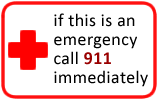Cold Sores
Cold Sores
Does this describe your symptoms? |
Click image for more info |
Definition
General Information
Are there any over-the-counter treatments for cold sores?
What can your physician prescribe for colds sores?
|
If not, see these topics
|
When to Call Your Doctor |
Call Your Doctor Now (night or day) If |
|
|
|
Call Your Doctor Within 24 Hours (between 9 am and 4 pm) If |
|
|
|
Call Your Doctor During Weekday Office Hours If |
|
|
|
Self Care at Home If |
|
|
HOME CARE ADVICE FOR COLD SORES |
General Information - Cold Sores
Fever blisters or cold sores occur on one side of the outer lip.
Typically lasts 7-10 days.
Treatment with a cold sore cream can reduce the pain and shorten the course by a day or two.
Docosonal 10% Cream:
Apply over-the-counter docosanol cream (trade name Abreva) to the cold sore 5 times daily until healing occurs.
Begin using this cream as soon as you first sense the beginning of an outbreak.
Docosonal is not available in Canada.
Read and follow the package instructions. Ask your physician's opinion.
Contagiousness:
Herpes from cold sores is contagious to other people. Try not to pick or rub the sore. Do not open the blisters. Wash your hands frequently. The cold sores are contagious until dry (approximately 5 days).
Most cold sore sufferers note a tingling in the lip before the sore appears (prodromal phase). Patients are also contagious during this time period.
Eyes - Avoid spreading the virus to someone's eye by kissing or touching; an eye infection can be serious (Herpes keratitis).
Mouth - Since the blisters and mouth secretions are contagious, avoid kissing other people during this time. Avoid sharing drinking glasses, eating utensils, or razors.
Sex - Avoid oral sex during this time. Herpes from sores on your mouth can spread to your partner's genital area.
Contact with Immunocompromised People - Avoid contact with anyone who has eczema or a weakened immune system.
Expected Course: The pain typically subsides over 4-5 days and the sores typically heal over a 7-10 day period. On average, patients note recurrences 2-3 times per year.
Prevention: Since cold sores are often triggered by exposure to intense sunlight, use a lip balm containing a sunscreen (SPF 30 or higher).
Recurrence: Tingling or burning on the outer lip where cold sores previously occurred is an early sign of the new onset of recurrent cold sores.
National Herpes Hotline: Phone number - (919) 361-8488. Counselors provide information about transmission, treatment, prevention, and emotional issues. The hotline is open from 9 AM to 7 PM, Eastern Time, Monday through Friday.
Call Your Doctor If:
Sores look infected (spreading redness)
Sores occur near or in the eye
Sores last longer than 10 days
You become worse
And remember, contact your doctor if you develop any of the "Call Your Doctor" symptoms.
Updated:
March 22, 2017




